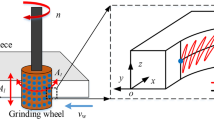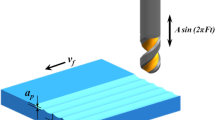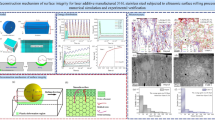Abstract
Ultrasonic rolling is an advanced non-cutting surface strengthening method that combines traditional rolling with ultrasonic vibration. In this research, the experiment of orthogonal end milling-ultrasonic rolling composite process has been carried out. The surface integrity refactoring changes and its mechanism of Ti-17 titanium alloy during the milling- ultrasonic rolling composite process has been studied and analyzed by the test and analysis of the surface geometric characteristics, residual stress, microhardness and microstructure before and after ultrasonic rolling. The residual stress and microhardness gradient distribution were characterized by cosine decay function and exponential decay function. All indicators of surface integrity were significantly improved after ultrasonic rolling. The study demonstrates that the reduction effect of the surface roughness by ultrasonic rolling process is inversely proportional to the initial surface roughness value. The ultrasonic rolling can only change the distribution form of the surface topography when the initial surface roughness is small. In addition, the improvement effect of ultrasonic rolling on surface compressive residual stress and microhardness decreased with the increase of initial milled surface roughness and surface compressive residual stress due to the factors such as energy absorption efficiency and mechanical properties changes of surface materials. A better ultrasonic rolled surface can be obtained by controlling the roughness and residual compressive stress of the initial milling surface to a small level.















Similar content being viewed by others
References
Wang F, Men X, Liu Y et al (2020) Experiment and simulation study on influence of ultrasonic rolling parameters on residual stress of Ti-6Al-4V alloy. Simul Model Pract Theory 104:102121. https://doi.org/10.1016/j.simpat.2020.102121
Wang N, Zhu J, Liu B et al (2021) Influence of ultrasonic surface rolling process and shot peening on fretting fatigue performance of Ti-6Al-4V. Chin J Mech Eng Engl Ed 34:1–13
Panin A, Kazachenok M, Perevalova O (2020) Surface modification of EBF3-Fabricated Ti-6Al-4V parts by ultrasonic impact treatment. In: AIP Conference Proceedings, Tomsk, 2020
Zhang Q, Li M, Han B et al (2021) Investigation on microstructures and properties of Al1.5CoCrFeMnNi high entropy alloy coating before and after ultrasonic impact treatment. J Alloys Compd 884:160989. https://doi.org/10.1016/j.jallcom.2021.160989
Meng D, Zhao X, Zhao S et al (2019) Effects of vibration direction on the mechanical behavior and microstructure of a metal sheet undergoing vibration-assisted uniaxial tension. Mater Sci Eng A 743:472–481
Chen Z, Liu C, Rani E et al (2021) Ultrasonic vibration-induced severe plastic deformation of Cu foils: effects of elastic-plastic stress wave bounce, acoustic softening, and size effect. Int J Adv Manuf Technol 115:3617–3629
Zohrevand M, Aghaie-Khafri M, Forouzan F et al (2021) Microstructural evolutions under ultrasonic treatment in 304 and 316 austenitic stainless steels: impact of stacking fault energy. Steel Res Int 92:1–12
Wang C, Hu X, Cheng Y et al (2021) Experimental investigation and numerical study on ultrasonic impact treatment of pure copper. Surf Coat Technol 428:127889. https://doi.org/10.1016/j.surfcoat.2021.127889
Geng J, Yan Z, Zhang H et al (2021) Microstructure and mechanical properties of AZ31B magnesium alloy via ultrasonic surface rolling process. Adv Eng Mater 23:1–7
Ao N, Liu D, Zhang X et al (2019) Surface nanocrystallization of body-centered cubic beta phase in Ti-6Al-4V alloy subjected to ultrasonic surface rolling process. Surf Coat Technol 361:35–41
Zhou M, Xu Y, Liu Y et al (2021) Microstructures and mechanical properties of Mg-15Gd-1Zn-0.4Zr alloys treated by ultrasonic surface rolling process. Mater Sci Eng A 828:141881. https://doi.org/10.1016/j.msea.2021.141881
Zhao W, Liu D, Zhang X et al (2019) Improving the fretting and corrosion fatigue performance of 300M ultra-high strength steel using the ultrasonic surface rolling process. Int J Fatigue 121:30–38
Wang P, Wang F, Pan Y et al (2020) Research on residual stress simulation on high performance aluminum alloy manufacturing. IOP Conf Ser Earth Environ Sci. https://doi.org/10.1088/1755-1315/440/2/022068
Dang J, An Q, Lian G et al (2021) Surface modification and its effect on the tensile and fatigue properties of 300M steel subjected to ultrasonic surface rolling process. Surf Coatings Technol 422:127566. https://doi.org/10.1016/j.surfcoat.2021.127566
Panin A, Dmitriev A, Nikonov A et al (2021) Transformations of the microstructure and phase compositions of titanium alloys during ultrasonic impact treatment. Part I. commercially pure titanium. Metals 11(4):562–574
Zheng GY, Luo X, Huang B et al (2021) Distributions of grains and precipitates in gradient lamellae Al-Zn-Mg-Cu alloy by ultrasonic surface rolling processing. Mater Sci Eng A. https://doi.org/10.1016/j.msea.2021.141911
Luo X, Ren X, Jin Q et al (2021) Microstructural evolution and surface integrity of ultrasonic surface rolling in Ti6Al4V alloy. J Mater Res Technol 13:1586–1598
Shen X, Gong X, Zhang J et al (2019) An investigation of stress condition in vibration-assisted burnishing. Int J Adv Manuf Technol 105:1189–1207
Meng Z, Yuanxi Z, Yang Z (2019) Theoretical and experimental analysis of compressive residual stress field on 6061 aluminum alloy after ultrasonic surface rolling process. Proc Inst Mech Eng Part C J Mech Eng Sci 233:5363–5376
Zhang M, Liu Z, Deng J et al (2019) Optimum design of compressive residual stress field caused by ultrasonic surface rolling with a mathematical model. Appl Math Model 76:800–831
Jiao F, Lan SL, Zhao B et al (2020) Theoretical calculation and experiment of the surface residual stress in the plane ultrasonic rolling. J Manuf Process 50:573–580
Li F, Zhao B, Lan S et al (2020) Experiment and simulation of the effect of ultrasonic rolling on the surface properties of Ti-6Al-4V. Int J Adv Manuf Technol 106:1893–1900
Liu Y, Wang F, Li H et al (2020) Study on ultrasonic rolling parameters to grain size of aluminum alloy 7075 surface. IEEE Int Conf Real-Time Comput Robot RCAR 2020:291–296. https://doi.org/10.1109/RCAR49640.2020.9303273
Duan Y, Qu S, Jia S et al (2021) Effects of ultrasonic surface rolling processing on microstructure and wear properties of high-carbon high-chromium steel. Surf Coat Technol 422:127531. https://doi.org/10.1016/j.surfcoat.2021.127531
Liu P, Wang R, Liu X et al (2021) Effect of surface ultrasonic rolling on evolution of surface microstructure of EA4T axle steel. J Mater Eng Perform 30:1270–1279
Arola D (2009) Surface texture and the stress concentration factor for FRP components with holes. J Compos Mater 37:1439–1460
Cheng Z, Liao R, Lu W (2017) Surface stress concentration factor via Fourier representation and its application for machined surfaces. Int J Solids Struct 113/114:108–117
Murakami Y (2019) Metal fatigue: effects of small defects and nonmetallic inclusions, Academic Press, London
Johnson KL (1987) Contact mechanics, Cambridge University Press, Cambridge
Bai Y, Yang M (2016) The influence of superimposed ultrasonic vibration on surface asperities deformation. J Mater Process Technol 229:367–374
Li G, Qu S, Xie M et al (2017) Effect of multi-pass ultrasonic surface rolling on the mechanical and fatigue properties of HIP Ti-6Al-4V alloy. Materials (Basel). https://doi.org/10.3390/ma10020133
Acknowledgements
This work was supported by the National Natural Science Foundation of China (Grant Nos. 51875472, 91860206, 51905440, and 92160301), the National Science and Technology Major Project (Grant No. 2017-VII-0001-0094), and the Key Research and Development Program of Shaanxi Province (Grant No. 2021ZDLGY10-06).
Author information
Authors and Affiliations
Corresponding author
Rights and permissions
Springer Nature or its licensor (e.g. a society or other partner) holds exclusive rights to this article under a publishing agreement with the author(s) or other rightsholder(s); author self-archiving of the accepted manuscript version of this article is solely governed by the terms of such publishing agreement and applicable law.
About this article
Cite this article
Zhou, Z., Yao, CF., Tan, L. et al. Experimental study on surface integrity refactoring changes of Ti-17 under milling-ultrasonic rolling composite process. Adv. Manuf. 11, 492–508 (2023). https://doi.org/10.1007/s40436-022-00435-9
Received:
Revised:
Accepted:
Published:
Issue Date:
DOI: https://doi.org/10.1007/s40436-022-00435-9




